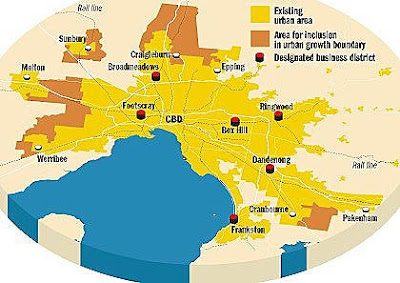 |
| Next step, living in the Bay? |
Already struggling under the demands placed upon it by over 4million people, Melbourne's vital infrastructure and public services will be stretched beyond capacity if more people are accommodated further away from the city's centre.
Now I'm all for having more people live in Melbourne, and in Australia in general, but it must be regulated to fit the needs of Australia's developing economy. Given the size of our land, the number of people occupying it and the relative abundance of our natural resources, Australia's economy is operating well below its capabilities. Broadly speaking, many foreigners are amazed at the size of our continent, and the small number of people making use of it. The skill set required for our country to grow into a true world "player" must be actively sought out by government schemes, while encouraging those in the corporate sector to bring foreigners here who will add to the country, economically, socially and culturally.
 |
| A typical Melbourne Traffic jam, rendering the speed limit useless. |
 |
| Melbourne Train System |
A small and unscientific analysis of three cities, Melbourne, London and New York City, sheds light on the long term planning that didn't take place. In terms of population size, New York City holds about .4 million more people than London, with the British capital holding just under 8mil. Melbourne holds under half that, with our population currently hovering around 4 million.
In terms of physical land size, Melbourne, in square kilometres, completely blows New York and London out of the park, with its area totalling 8806sq.km, London in second at 1706.8sq.km and NYC relatively small at 1214.4sq.km.
 |
| Greater London Trains- Underground and Above-ground systems |
New York's rail network is much more extensive, with 24 lines connecting 468 stations and the ability to carry over 5 million passengers per weekday. It began service in 1904, which begs the question, why didn't Melbourne's planners think long term and build for the future. One common feature of the New York and London system, is that they do not incorporate a central hub to which each and every train must pass, although there are areas of increased connectivity and no doubt activity.
Having greater connectivity and no central hub, makes it easier for people who have no need to enter the congested zones, get to their destinations. The ability to get from home to work, or from Frankston to Clayton, without having to catch 1 train and 2 buses, or 2 different trains and a bus etc.
The improvements required for the upgrading of Melbourne's rail network towards a modern, efficient, user friendly system, will require a lot of planning, international consultation, expertise and last but not least, foresight and a vested interest in making Melbourne a better city.
We can undoubtedly make Melbourne more attractive to the rest of the world by improving our public transport, but if we want to preserve our unique lifestyle and make it easier for families to live and grow, we must accept the need to become an economy of scale. To allow for more people, we must also recognize and accept the fact that living habits must change, and that some luxuries currently afforded to most of the population, must be sacrificed if we are to maintain financial prosperity. Many of the houses built in the late 50s and 60s are medium sized, well built homes that lie on massive amounts of unused garden space(see left). However, the structure of our modern society is such that most gardens go under used and under appreciated, with more and more people flocking to public gardens and parks to meet friends and conduct various recreational activities. So what purpose do expansive areas of grass, weeds and plants serve? Gone are the days in which children played with their friends in an unstructured manner.More kids are enrolled in after school care programs and are involved in club sports, martial arts, swimming, dance, drama and gymnastics than ever before; activities meant to add structure to children's lives and developing their all round skills.This is also symptomatic of the work/life balance afforded to their parents, who would rather spend money enrolling their kids in such activities than spending personal time with them. The amount of time they spend in their own front or back yard with their kids is lower than ever before, and its not something working families are willing to change.
So the main advantage of owning land along with a house, is prestige. But what value do people place on owning land that they do not use? Wouldn't they benefit more from selling their land and obtaining cash for it? would Melbourne as a city, not be better off if people capitalized from the land that they own by developing upwards? If we were to sacrifice our front and back yards, build longer and wider, single story houses, developing second and third stories would generate revenue for land owners, and easily accommodate the predicted population increase


No comments:
Post a Comment